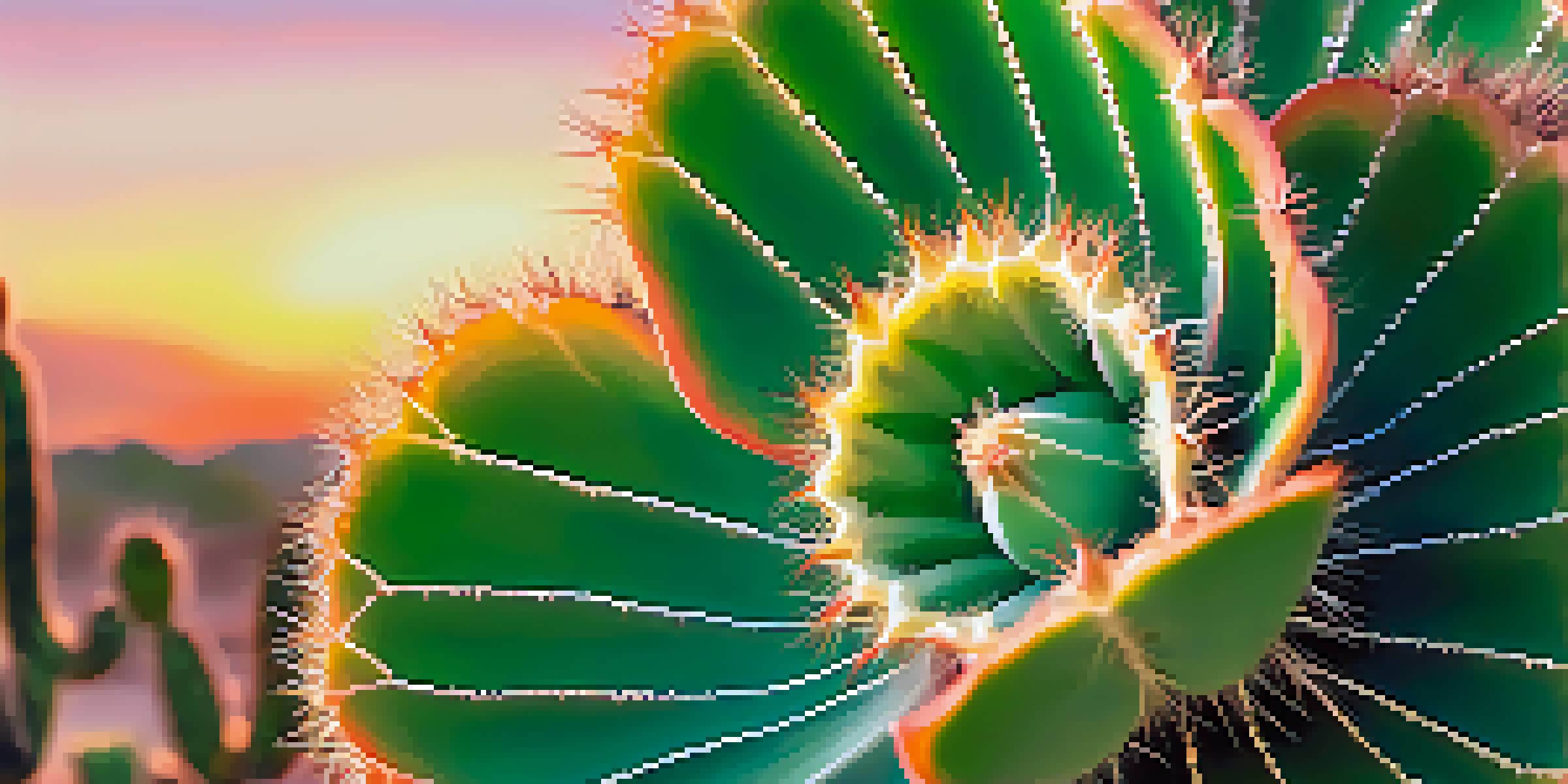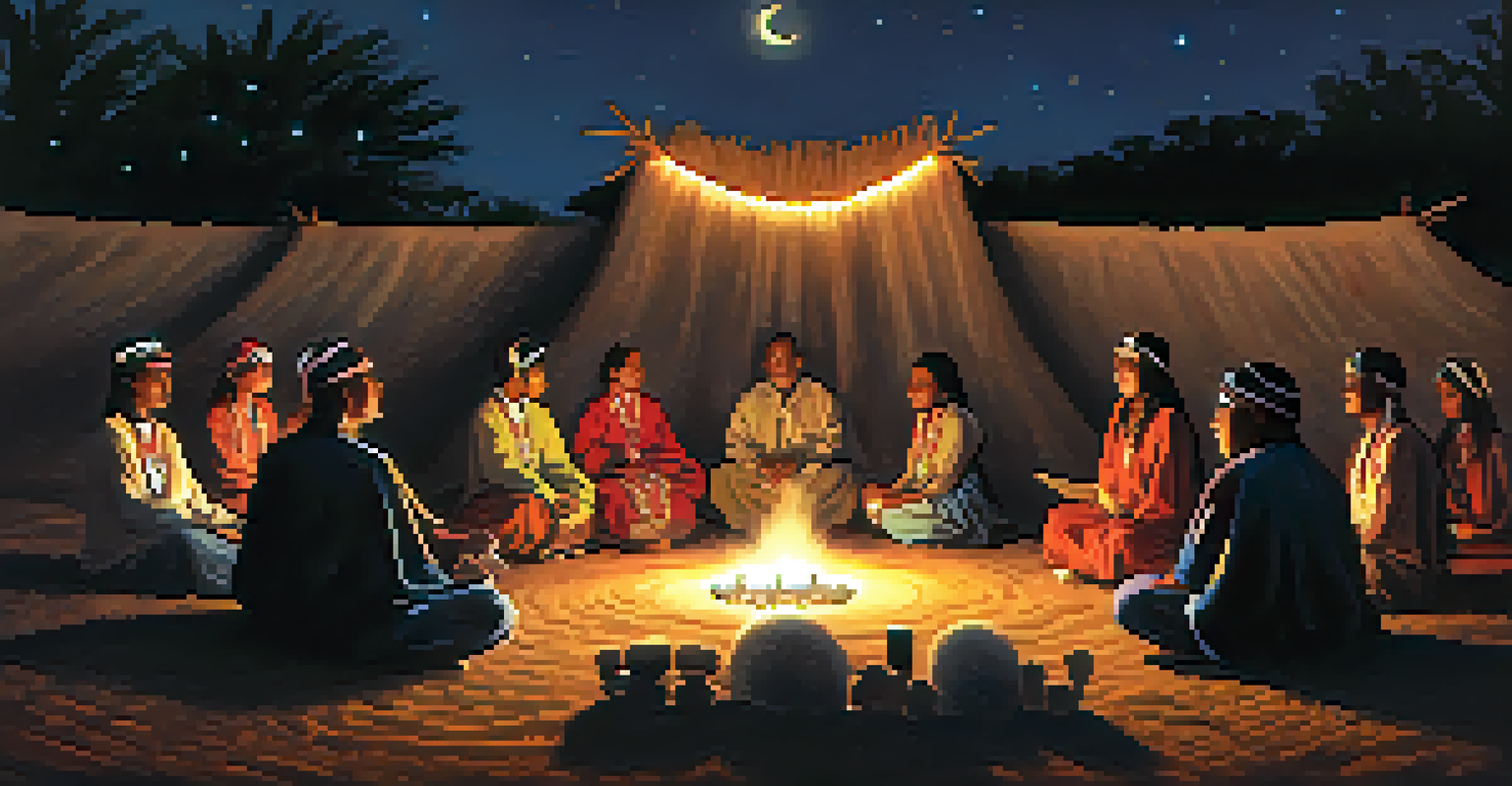The Cultural History of Peyote in Indigenous Medicine

Understanding Peyote: A Sacred Cactus
Peyote, scientifically known as Lophophora williamsii, is a small cactus native to the southwestern United States and Mexico. This unique plant has been revered for centuries by various Indigenous cultures for its psychoactive properties. Traditionally, peyote is consumed in small amounts, leading to altered states of consciousness that many believe facilitate spiritual experiences and healing.
Psychedelics are not just a way to escape from reality; they can be a path to understanding it more deeply.
The use of peyote is deeply intertwined with the identity of many Indigenous tribes. For these communities, the cactus serves not only as a medicinal tool but also as a vital component of cultural rituals and ceremonies. Understanding peyote requires a recognition of its significance beyond mere substance; it embodies the spiritual and historical narratives of the people who honor it.
In many ways, peyote acts as a bridge between the physical and spiritual worlds. It is believed to provide insights, guidance, and a sense of connection to ancestors, making it an essential element in the practices of tribes like the Huichol and the Navajo. This connection highlights the importance of respecting these traditions and the sacredness of the peyote experience.
Historical Context of Peyote Usage
The history of peyote use among Indigenous peoples dates back thousands of years, with archaeological evidence suggesting its consumption as far back as 5,500 years ago. Early records indicate that the Huichol people of Mexico have used peyote for both religious and medicinal purposes, establishing a tradition that continues to this day. This long-standing history underscores the deep-rooted significance of the cactus in Indigenous culture.

Peyote's recognition as a sacred plant has evolved over time, particularly as it came into contact with European settlers. While some Indigenous groups embraced the sharing of their practices, others faced oppression and misunderstanding regarding their traditions. This led to a complex relationship with peyote, as it became a symbol of resistance against colonial forces and an assertion of cultural identity.
Peyote's Cultural Significance
Peyote is deeply embedded in Indigenous cultures, serving as a symbol of identity, resilience, and connection to heritage.
Moreover, the introduction of peyote to non-Indigenous populations in the early 20th century sparked both interest and controversy. As the use of peyote spread beyond Indigenous communities, it prompted discussions about cultural appropriation and the ethical implications of using sacred plants for recreational purposes. This historical narrative serves as a reminder of the delicate balance between respect and reverence for Indigenous traditions.
Peyote in Ceremonial Practices
Ceremonies involving peyote are often centered around healing, community bonding, and spiritual growth. The Native American Church, which emerged in the late 19th century, has played a pivotal role in formalizing the use of peyote in religious practices. These ceremonies are generally led by a spiritual leader and involve music, prayer, and communal sharing, elevating the experience to one of profound significance.
Tradition is not the worship of ashes, but the preservation of fire.
During these gatherings, participants consume peyote in a safe and supportive environment, allowing for introspection and emotional release. The ceremonial use of peyote is not merely about ingestion but involves a holistic approach to healing that encompasses body, mind, and spirit. This multifaceted process reinforces the idea that peyote serves as a conduit for transformative experiences.
The significance of these ceremonies extends beyond individual healing; they foster community ties and strengthen cultural identity. By participating in peyote ceremonies, individuals reaffirm their connection to their heritage and the collective wisdom of their ancestors. This communal aspect highlights the importance of shared experiences in Indigenous cultures, where healing is often viewed as a collective journey.
Medicinal Properties of Peyote
Peyote's psychoactive compound, mescaline, has garnered attention for its potential therapeutic benefits. Research suggests that mescaline may aid in alleviating symptoms of anxiety, depression, and PTSD, presenting a promising avenue for modern medicine. Indigenous practices that incorporate peyote often highlight these healing properties, emphasizing the plant's role in emotional and mental well-being.
The traditional knowledge surrounding peyote and its effects has been passed down through generations, showcasing a profound understanding of its medicinal qualities. Indigenous healers often utilize peyote in conjunction with other natural remedies, creating a holistic approach to health. This integrated method emphasizes the balance between physical, mental, and spiritual health.
Medicinal Benefits of Mescaline
Research indicates that mescaline, the psychoactive compound in peyote, may offer therapeutic benefits for mental health issues like anxiety and PTSD.
As contemporary science begins to explore the potential benefits of peyote, it is essential to approach this research with respect for Indigenous knowledge systems. Collaborations between Western medicine and Indigenous practices could pave the way for a more comprehensive understanding of mental health treatments. This synergy highlights the value of traditional wisdom in modern contexts.
Legal Challenges Surrounding Peyote
The legal status of peyote has been a contentious issue, particularly in the United States. While peyote remains illegal for recreational use, its consumption is protected for members of the Native American Church under specific circumstances. This legal framework reflects a complex balance between cultural rights and societal regulations, often leading to debates about Indigenous sovereignty.
Moreover, as interest in psychedelics grows, the conversation surrounding peyote is increasingly relevant. Some advocates argue for broader access to peyote for therapeutic purposes, while others caution against commercializing a sacred plant. This tension emphasizes the need for respectful dialogue about the cultural significance of peyote and the potential consequences of its appropriation.
Legal challenges also highlight the importance of protecting Indigenous practices and ensuring that they are not exploited. As discussions about drug policy evolve, it is crucial to include Indigenous voices in these conversations. Empowering Indigenous communities to have a say in the future of peyote ensures that their traditions remain respected and preserved.
Cultural Significance Beyond Medicine
Beyond its medicinal applications, peyote plays a vital role in the cultural landscape of Indigenous communities. It serves as a symbol of resilience, identity, and connection to the land. For many, peyote is not just a plant but a representation of their history, beliefs, and values, woven into the very fabric of their society.
Art, music, and storytelling often reflect the significance of peyote, showcasing its influence on various cultural expressions. From intricate beadwork to powerful songs, Indigenous artists draw inspiration from their relationships with peyote, capturing its essence in creative forms. This artistic representation underscores the multifaceted role of peyote in everyday life.
Legal Challenges for Indigenous Use
The legal status of peyote remains complex, balancing Indigenous cultural rights with societal regulations, especially as interest in psychedelics grows.
Additionally, peyote's cultural significance extends to the younger generations, who are increasingly seeking to reconnect with their heritage. As more Indigenous youth engage with traditional practices, peyote serves as a gateway to understanding their cultural roots. This revival of interest fosters a sense of pride and belonging, ensuring that the legacy of peyote continues to thrive.
The Future of Peyote in Indigenous Cultures
As we look to the future, the role of peyote in Indigenous cultures faces both challenges and opportunities. The growing interest in psychedelics opens doors for greater understanding and dialogue about the plant's cultural significance. However, this also raises concerns about the potential commercialization and misappropriation of peyote, which must be addressed with care and respect.
Indigenous communities are actively navigating these changes, advocating for their rights to practice their traditions. By asserting their sovereignty and engaging with modern society, they aim to protect their cultural heritage while sharing their wisdom with the world. This delicate balance is crucial for ensuring that peyote continues to be honored as a sacred medicine.

Ultimately, the future of peyote lies in the hands of those who hold its traditions dear. As Indigenous voices gain visibility, there is hope for a respectful coexistence that honors both cultural practices and modern scientific inquiry. This collaborative approach could pave the way for a deeper understanding of peyote and its invaluable contributions to the tapestry of human experience.